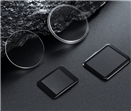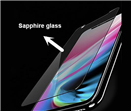

Time:2025-01-15
Sapphire glass, as a high-strength glass material, is a crystal material made of aluminum oxide (Al ? O3) through special processes. This material has high hardness and can resist most daily scratches and wear. In addition, it also has high optical performance, including high transmittance, low dispersion, and good chemical stability, which enables it to maintain excellent performance in various extreme environments, demonstrating its performance and wide application value in many fields. This article will explore the characteristics, manufacturing process, and application fields of sapphire glass.
1、 Production process
The production process of sapphire glass is relatively complex, mainly including several key steps such as raw material preparation, melting, crystallization, cutting, and polishing. In terms of raw materials, high-quality alumina powder is the foundation, and through precise proportioning and mixing, the purity and uniformity of the product are ensured. The melting process needs to be carried out under high temperature and high pressure to melt the alumina powder and form a continuous crystal structure. Subsequently, by slow cooling, crystal growth is promoted to form large pieces of sapphire glass. Cutting and polishing are key steps in processing large pieces of material into the desired shape and size, requiring high precision and skill to ensure the optical performance and aesthetics of the product.

2、 Application Fields
Thanks to its high strength, high wear resistance, and excellent optical performance, it has found its place in multiple fields:
1. Smart watches and mobile phone screens: With the popularity of smart wearables and smartphones, users' demand for screen durability is increasing. Due to its scratch resistant and wear-resistant properties, it has become an ideal choice for smart device screens, effectively improving the product's lifespan and user experience.
2. Optical components: In optical instruments such as camera lenses, telescopes, microscopes, etc., sapphire glass's high transmittance and low dispersion characteristics enable it to provide clearer and more realistic image quality, making it a trusted material for professional photographers and researchers.
3. Aerospace: In extreme environments such as high temperature, high pressure, and strong radiation, ordinary glass materials are often difficult to handle. With its chemical stability and high temperature resistance, it is used in the aerospace industry to make key components such as observation windows and sensor protective covers, ensuring the safety and success of missions.
4. Jewelry: With its unique blue luster and hard texture, it is also used to make jewelry such as watch dials, rings, etc., meeting consumers' pursuit of beauty and quality requirements.
5. Medical equipment: In medical equipment such as endoscopes, surgical blades, etc., the wear-resistant and corrosion-resistant properties of sapphire glass enable it to maintain sharpness and cleanliness for a long time, improving the safety and efficiency of surgery.
Sapphire glass, as a high-strength and wear-resistant glass material, has demonstrated its unique value and potential in multiple fields. With the advancement of technology and the growth of demand, it will play a role in more fields and write its own chapter with its performance.






Tel
Mobile phone
Customer service
TOP